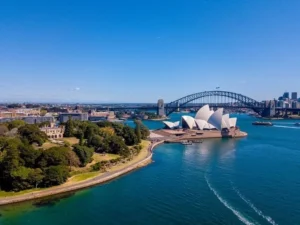Australia is a top destination for international students due to its world-class education system, vibrant culture, and high quality of life. If you are planning to study in Australia, obtaining an Australia Student Visa is essential. This guide will provide you with comprehensive information on the Australia study visa requirements, important study abroad exams, and other key aspects of the student visa process.
Why Study in Australia?
Australia is home to some of the world’s best universities, offering high-quality education across various fields. The country provides a multicultural environment, excellent job opportunities, and a high standard of living. Moreover, Australian universities rank among the top institutions globally, making them a preferred choice for students worldwide.
Types of Australia Student Visa
The primary visa for international students is the Subclass 500 Student Visa, which allows students to stay in Australia for the duration of their studies. This visa provides the flexibility to work part-time and gain valuable experience while studying.
Benefits of an Australia Student Visa:
- Study full-time at an Australian educational institution.
- Work up to 48 hours per fortnight during academic sessions.
- Stay for up to five years, depending on the course duration.
- Opportunity to bring dependents (spouse or children) under specific conditions.
Australia Study Visa Requirements
Before applying for an Australia Student Visa, you must meet certain Australia study visa requirements, including:
1. Enrollment in a Recognized Course
You must have a Confirmation of Enrolment (CoE) from an Australian institution registered under the Commonwealth Register of Institutions and Courses for Overseas Students (CRICOS).
2. Proof of Financial Capacity
You need to provide evidence that you have sufficient funds to cover tuition fees, living expenses, and travel costs. As of recent updates, you must demonstrate access to at least AUD 24,505 per year.
3. English Language Proficiency
To study in Australia, you must meet English language requirements through study abroad exams such as:
- IELTS (International English Language Testing System)
- TOEFL (Test of English as a Foreign Language)
- PTE Academic (Pearson Test of English)
- Cambridge Advanced English (CAE)
4. Genuine Temporary Entrant (GTE) Requirement
You must prove that your intention to study in Australia is genuine and that you plan to return to your home country after completing your studies.
5. Health and Character Requirements
Students must undergo a medical examination and obtain Overseas Student Health Cover (OSHC) for the entire duration of their stay. Additionally, applicants need to provide a police clearance certificate.
Study Abroad Exams Required for an Australia Student Visa
Different universities and courses have specific entry requirements, including study abroad exams that assess language proficiency and academic abilities. Some of the key exams include:
1. IELTS
The IELTS exam is widely accepted by Australian universities. A minimum band score of 6.0 to 7.0 is usually required, depending on the course and institution.
2. TOEFL
TOEFL scores are accepted by many Australian universities, with minimum score requirements typically ranging from 60 to 90.
3. PTE Academic
The PTE Academic exam is gaining popularity among Australian institutions. A minimum score of 50 to 65 is generally required.
4. GMAT and GRE (For Postgraduate Programs)
Students applying for MBA or other postgraduate programs may need to take the GMAT or GRE, depending on university requirements.
Step-by-Step Process to Apply for an Australia Student Visa
Step 1: Choose a Course and Institution
Select an appropriate course and ensure the institution is registered under CRICOS.
Step 2: Receive Confirmation of Enrolment (CoE)
After receiving an offer letter and paying the required fees, the university will issue a CoE.
Step 3: Gather Required Documents
Prepare necessary documents, including:
- CoE from the university
- Proof of financial capacity
- English language test scores (from study abroad exams like IELTS, TOEFL, or PTE)
- Health insurance (OSHC)
- GTE statement
Step 4: Submit Online Visa Application
Apply for the Subclass 500 Student Visa through the Australian Immigration website and pay the visa application fee.
Step 5: Attend Biometrics and Health Check
Depending on your country of residence, you may need to provide biometrics and undergo a medical examination.
Step 6: Await Visa Approval
Visa processing times vary, typically taking between 4 to 12 weeks.
Post-Visa Approval: What’s Next?
Arriving in Australia
Once your Australia Student Visa is approved, you can make travel arrangements and plan your accommodation.
Work Opportunities for Students
The Australia Student Visa allows students to work up to 48 hours per fortnight during study periods and unlimited hours during semester breaks.
Pathways to Permanent Residency
After completing your studies, you may explore pathways to permanent residency through:
- Temporary Graduate Visa (Subclass 485)
- Employer-sponsored visas
- Skilled Migration programs
Common Challenges and How to Overcome Them
1. Meeting Financial Requirements
Plan your finances in advance and ensure you have the necessary bank statements and sponsorship letters.
2. Achieving Required English Scores
Prepare thoroughly for study abroad exams like IELTS or PTE by taking practice tests and enrolling in preparatory courses.
3. Understanding Visa Conditions
Adhere to all visa conditions, including maintaining enrollment, attending classes, and not exceeding the permitted work hours.
Conclusion
Securing an Australia Student Visa is the key to unlocking a world-class education in Australia. Understanding the Australia study visa requirements, preparing for necessary study abroad exams, and following the visa application process diligently will help ensure a smooth journey. If you need assistance with your visa application, professional guidance from experts like Phoenix GRS can make the process seamless.
Start your study abroad journey today and experience the academic excellence and cultural diversity that Australia has to offer!




